When’s the next meteor shower? The Quadrantids peak on the night of January 3, 2023! Our Meteor Showers Calendar for 2023 has the dates, best time to view, number per hour, point of origin, and associated comet—plus, viewing tips.
Advertisement
2023 Meteor Shower Calendar
The dates of major meteor showers do not change much from year to year, though the peak (or “maximum”) of a shower may vary by a day or two. We’ve listed these peak dates in the table below, along with the average number of meteors to expect to see per hour (in prime conditions) and the best viewing time for each shower. More detailed information about each meteor shower can be found below the table.
Find viewing tips for the two biggest meteor showers here: the Perseid Meteor Shower and the Geminid Meteor Shower.
| Principal Meteor Showers |
| SHOWER |
BEST VIEWING |
POINT OF ORIGIN |
DATE OF MAXIMUM* |
NO. PER HOUR** |
ASSOCIATED COMET |
| Quadrantid |
Predawn |
N |
Jan. 3–4 |
25 |
— |
| Lyrid |
Predawn |
S |
Apr. 21–22 |
10 |
Thatcher |
| Eta Aquarid |
Predawn |
SE |
May 4–5 |
10 |
Halley |
| Delta Aquarid |
Predawn |
S |
July 29-30 |
10 |
— |
| Perseid |
Predawn |
NE |
Aug. 11–13 |
50 |
Swift-Tuttle |
| Draconid |
Late evening |
NW |
Oct. 8–10 |
6 |
Giacobini-Zinner |
| Orionid |
Predawn |
S |
Oct. 20–21 |
15 |
Halley |
| Northern Taurid |
Late evening |
S |
Nov. 11–12 |
3 |
Encke |
| Leonid |
Predawn |
S |
Nov. 16–18 |
10 |
Tempel-Tuttle |
| Andromedid |
Late evening |
S |
Nov. 25–27 |
5 |
Biela |
| Geminid |
All night |
NE |
Dec. 13–14 |
75 |
— |
| Ursid |
Predawn |
N |
Dec. 21–22 |
5 |
Tuttle |
| *May vary by one or two days **Moonless, rural sky Bold = most prominent |
- “Predawn” means between midnight and about an hour before morning twilight. Best time to view most major showers.
- “Late evening” means approximately between 10 p.m. and midnight (or a little past).
Meteor Showers of 2023
Quadrantids | January 3–4, 2023
In the right conditions, the Quadrantids are one of the best meteor showers of the year, as they feature an average of 25 meteors per hour at their peak. The Quadrantids’ peak is quite short, lasting from about midnight to dawn, but the volume of meteors makes the experience worthwhile.
In 2023, the Moon will be 92% full, obscuring the fainter meteors. Your best bet is to view after the Moon sets on the 4th of January, just before dawn. See your Moon rise and set times.
Lyrids | April 21–22, 2023
The Lyrids reach their peak on the night of April 21–22, 2023, when you can expect to see an average of 10 meteors per hour in dark, clear skies. Rarely, the Lyrids produce surges of up to 100 meteors per hour. This meteor shower is visible from both the Northern and Southern Hemisphere, but is much more active in the Northern Hemisphere, where the meteors’ radiant is high in the sky.
In 2023, the Moon will only be 9% full during the Lyrids’ peak, setting early in the night sky. This means dark skies for what should be an excellent show!
Eta Aquarids | May 4–5, 2023
The Eta Aquarids are the result of dust and debris produced by Halley’s Comet as it circles the Sun. This meteor shower is most spectacular in the Southern Hemisphere, where the meteors’ radiant is higher in the sky. In the Northern Hemisphere, Eta Aquarids are often seen closer to the horizon.
In 2023, the eta Aquariids will be lost in the glare of the Moon, which is 100% full during the peak.
Delta Aquarids | July 29–30, 2023
The Delta Aquarids get their name from the constellation Aquarius, which they appear to emanate from. A weaker shower, the Delta Aquarids typically reach their peak in late July and produce between 10 and 20 meteors per hour around this time. A truly dark sky offers the best chance at seeing the Delta Aquarids, as they tend to not be as bright as some of the other meteor showers.
In 2023, the nearly-full Moon (95% full) will obscure most of the fainter meteors.
Perseids | August 11–13, 2023
The Perseids are one of the best meteor showers to observe with over 50 meteors per hour at its peak! Plus, we can all enjoy seasonable August nights.
In 2023, we are excited to report that the great Perseids will be unobstructed by the Moon’s glare; the Moon phase is only 10% full.
See our complete guide to the Perseid meteor shower.
Draconids | October 8–10, 2023
The Draconids aren’t the bigger show of the year, but they do mark the start of a busy season of meteor showers. After the Draconids, a shower happens every one to two weeks until late December.
The second quarter moon will dark skies in the early evening for what should be a good show. Best viewing will be in the early evening from a dark location far away from city lights.
In 2023, the shower will peak close to new Moon, and so moonlight will present minimal interference. The best time to watch the Draconids is early evening on October 8.
Orionids | October 20–21, 2023
The Orionids are named after one of the most recognizable constellations in the sky, Orion, from which these meteors appear to radiate. Often featuring some of brightest and fastest streaking stars, the Orionids appear in mid October and reach their peak in the hours before dawn on October 21.
In 2023, the Orionids will be visible. Though the Moon is 37% full (close to First Quarter), it sets around midnight, leaving dark skies for what could be a good show.
Leonids | November 17–18, 2023
The Leonids normally an average shower with 10 to 15 shooting stars per hour, but on rare occasions, they have been known to produce “meteor storms,” which result in thousands of meteors streaking across the sky. (We do not expect meteor storms this year.)
In 2023, the Moon will be 23% full. However, it will set before midnight, leaving dark skies for what should be a good show. Look after midnight through early morning.
Geminids | December 13–14, 2023
The Geminids are THE biggest meteor shower of the year and the shooting stars streak across the sky the entire night with 75 meteors per hour at its peak. Plus, it gets dark early so you don’t have to stay up until the week hours to see theK king of the meteor showers.
In 2023, the peak is near the new Moon. It’s going to be a GREAT year for the Geminids! Plan ahead if you can to ensure you’re some place with very dark skies.
See our complete guide to the Geminid meteor shower.
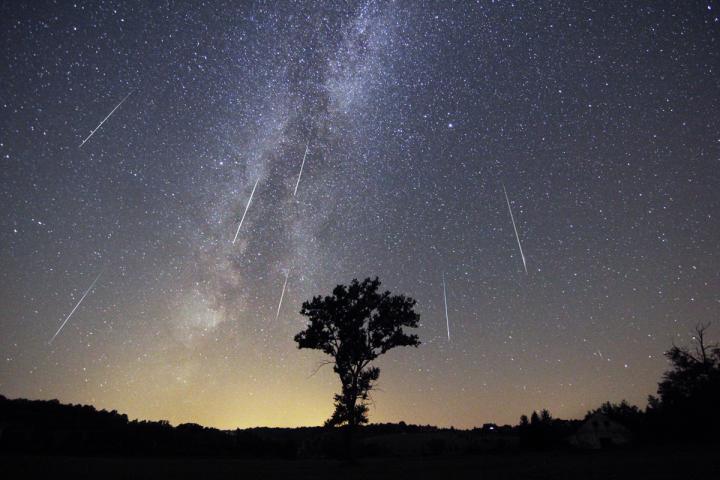
Meteor Showers Viewing Tips
- The most common question is “Where can I see the meteor showers?” The answer is: ANYWHERE in the sky! During a meteor shower, meteors can appear at any location, not just near their radiant. (The radiant is the location in the sky from which the paths of meteors in a meteor shower appear to originate, from our perspective on Earth. For example, the constellation Perseus is the radiant for the Perseids meteor shower; constellation Leo, the Leonids.) As far as viewing location on Earth, several major meteor showers can be seen in both Hemispheres, but others might be better seen in one or the other, depending on how far above or below the horizon the radiant is located. The Ursids, for example, are essentially seen only in the Northern Hemisphere, as the radiant is too far north of the equator for good viewing in the Southern Hemisphere.
- When are meteor showers? See the chart above for “date of maximum,” which lists the peak of each meteor shower (when the shooting stars will be most frequent). The time of the year for each shower is determined by when in Earth’s orbit it crosses the stream of meteoroids.
- What time can I see the meteor showers? See the chart above for the best viewing time. In nearly all showers, the radiant is highest just before dawn, but any time beween midnight and dawn gives you a view of most meteors head-on, for a more frequent display. Starting around midnight, your location on the globe spins around to the forward-facing half of Earth (in relation to the direction of orbit). At dawn, your location on the globe directly faces the direction in which Earth is traveling along its orbit.
- Note: the Geminid meteor shower is visible all night long, since Gemini appears just an hour or two after nightfall; the radiant is highest a little after midnight.
- Where to look? The best place to start is between the radiant and the zenith (straight above you in the sky). (Once again, the radiant is where the meteors appear to start from.) See the “point of origin” above.
- How to look? You don’t need any special equipment. In fact, binoculars do not work well for meteor showers. The naked eye is your best tool!
Dark Skies, Clear Skies Needed!
- The sky needs to be dark, away from all the city lights. Try to get to a viewing site as far as possible from bright lights. This may require planning—for a country drive or a campout.
- Bright moonlight, within a few days of a full Moon will reduce the number of meteors that you will see. Check our Full Moon Chart.
- Obviously, the weather needs to cooperate so that the skies are clear.
- Look for a location with a wide-open view of the sky, free from obstructions like tall trees or buildings.
- Spend about 20 minutes outside for your eyes to fully adjust to the darkness of the night sky.
- Spead a blanket on the ground and get cozy!
For more information, click here to read our article, “What are Meteor Showers: Facts About Shooting Stars.”
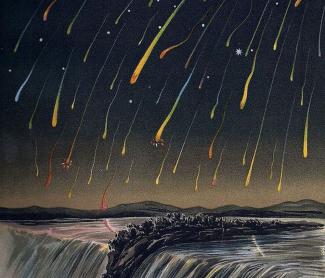


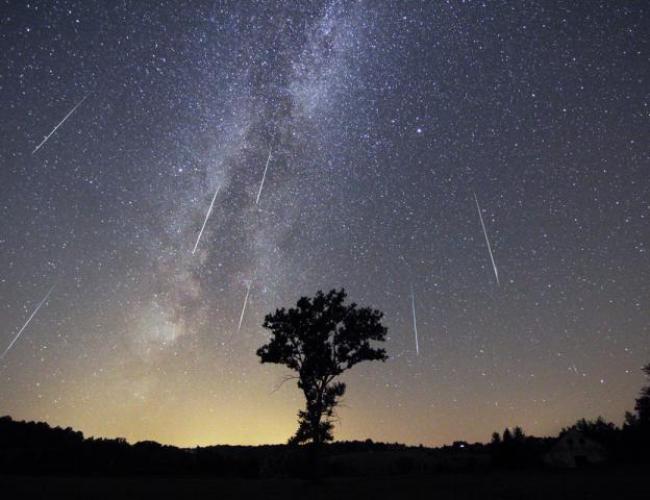
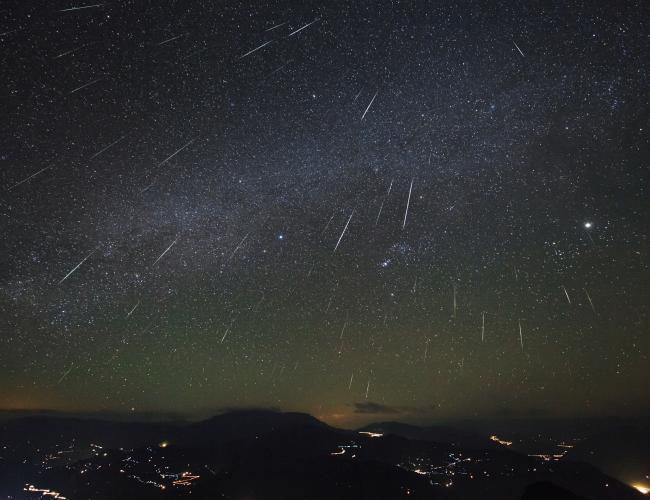
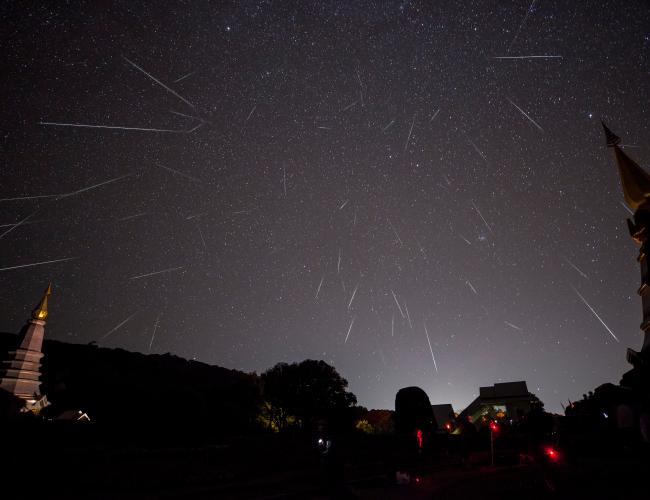
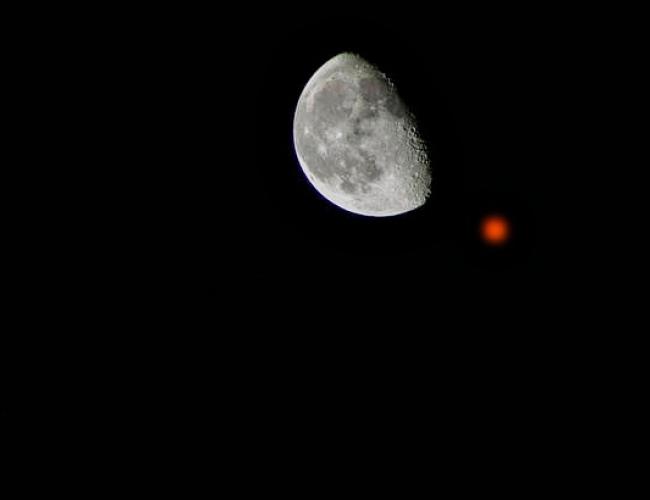
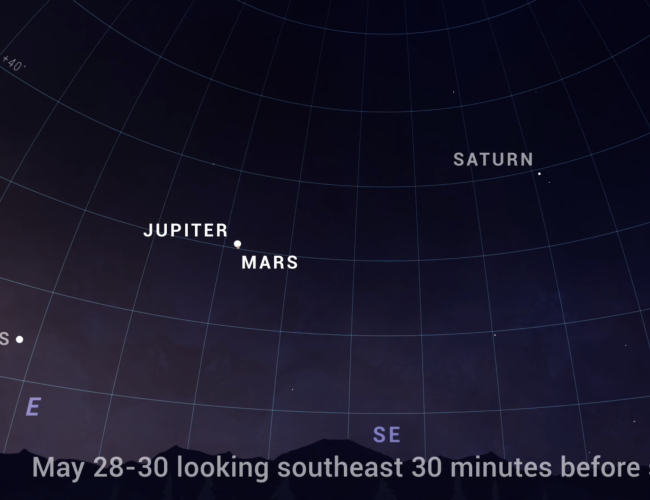
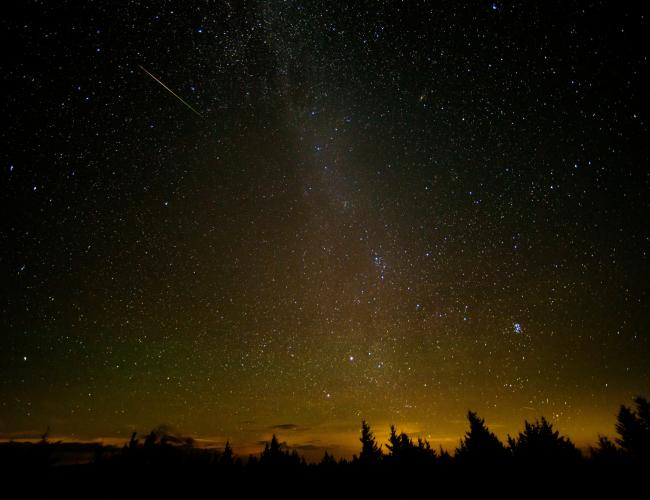


Comments